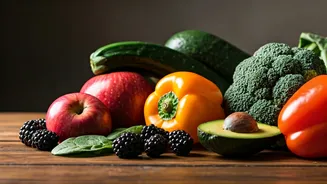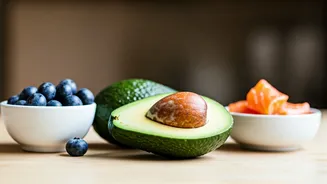Embrace Leafy Greens
Leafy green vegetables are nutritional powerhouses and a cornerstone of a diabetes-friendly diet. Spinach, kale, and other greens are low in carbohydrates
and calories but packed with vitamins, minerals, and antioxidants. These components work together to mitigate the effects of oxidative stress, a key factor contributing to insulin resistance and diabetes progression. Incorporating these greens into your diet helps improve insulin sensitivity, assisting your body in using glucose effectively. Further, they are high in fiber, which promotes slower sugar absorption, preventing rapid spikes in blood glucose levels after meals. Consider starting your day with a green smoothie or including them in salads, soups, or stir-fries for an added boost of health benefits. These choices provide valuable nutrients, making them a wise decision for anyone looking to manage or reverse type 2 diabetes. Choosing the correct foods is a key first step.
Prioritize Fatty Fish
Fatty fish, such as salmon, mackerel, and sardines, are excellent choices because they are rich in omega-3 fatty acids, crucial for overall health and blood sugar regulation. Omega-3s possess anti-inflammatory properties, which can aid in reducing inflammation, often associated with insulin resistance and the development of type 2 diabetes. In addition, these fishes contain high levels of protein, which contributes to satiety and can help with weight management, an important factor in managing diabetes. Regularly eating fatty fish can assist in improving insulin sensitivity. They also contribute to cardiovascular health, a significant concern for those with diabetes. Aim to include fatty fish in your diet at least twice a week by grilling, baking, or poaching. By integrating this into your meal plan, you can significantly enhance your body's ability to manage blood sugar and support your cardiovascular wellness.
Choose Whole Grains
Whole grains are substantially different from refined grains, offering substantial benefits in managing type 2 diabetes. Foods like brown rice, quinoa, and oats provide sustained energy release due to their complex carbohydrates and high fiber content. This slows down the absorption of sugar into the bloodstream, preventing those abrupt spikes in blood glucose that often accompany refined grains. These grains also help in improving insulin sensitivity, allowing the body to use insulin more effectively. The fiber component enhances digestive health and encourages a feeling of fullness, which can support weight management. Opting for whole grains over refined versions is a simple but impactful change. This switch could greatly impact your blood sugar levels and overall health. Incorporating whole grains into your daily meals will prove a helpful step toward managing diabetes and boosting your overall well-being.
Incorporate Nuts and Seeds
Nuts and seeds are nutrient-dense foods providing healthy fats, fiber, and protein, all crucial for managing blood sugar levels. Almonds, walnuts, flaxseeds, and chia seeds offer a combination of nutrients that help regulate glucose metabolism and improve insulin sensitivity. The fiber content in these foods aids in slowing down glucose absorption, which prevents rapid increases in blood sugar after meals. Furthermore, the healthy fats in nuts and seeds contribute to overall heart health, crucial for individuals with diabetes who are at a greater risk of cardiovascular disease. When choosing nuts and seeds, opt for unsalted varieties to avoid extra sodium, and consume them in moderation because they are calorie-dense. Including these food choices as snacks or in meals will provide essential nutrients, which is beneficial for diabetes management.
Embrace Berries
Berries like blueberries, strawberries, and raspberries are excellent additions to a diabetes-friendly diet because of their high fiber and antioxidant content. These fruits are naturally low in sugar but rich in antioxidants, which aid in fighting oxidative stress and reducing inflammation. This is especially helpful because chronic inflammation can hinder insulin function and contribute to insulin resistance. The fiber in berries also slows down the absorption of glucose, helping to maintain stable blood sugar levels. Additionally, berries provide essential vitamins and minerals, supporting overall health. Enjoy berries as a snack, add them to your breakfast, or include them in desserts. Making berries a regular part of your diet provides a sweet treat and essential nutrients that benefit diabetes management.
Use Yogurt Daily
Yogurt, especially the unsweetened, plain varieties, can be a great addition to your diet. Yogurt is a good source of protein, which aids in satiety and helps manage weight. Choose yogurt without added sugars to avoid unnecessary carbohydrate intake. Probiotics in yogurt can boost gut health, potentially improving insulin sensitivity. The benefits make yogurt a great choice for those aiming to manage type 2 diabetes. Plain yogurt can be a base for breakfast with berries and nuts or as a snack. Including yogurt in your diet gives essential nutrients and offers a health-promoting foundation for those managing diabetes.
Select Healthy Fats
Healthy fats are an important component for managing type 2 diabetes and promoting overall health. Sources like avocados, olive oil, and certain nuts offer monounsaturated and polyunsaturated fats, which contribute to improved insulin sensitivity and reduced inflammation. These fats help stabilize blood sugar levels and support cardiovascular wellness. Avocado is rich in fiber and beneficial fats, making it a great food option. Olive oil can be used for cooking or as a salad dressing, offering a healthy alternative to saturated fats. Including healthy fats can support better blood sugar control and promote an overall healthier dietary pattern for individuals managing type 2 diabetes.











